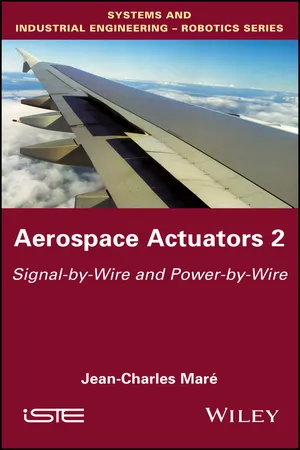
Aerospace Actuators 2
Signal-by-Wire and Power-by-Wire
Jean-Charles Maré
- English
- ePUB (apto para móviles)
- Disponible en iOS y Android
Aerospace Actuators 2
Signal-by-Wire and Power-by-Wire
Jean-Charles Maré
Información del libro
This book is the second in a series of volumes which cover the topic of aerospace actuators following a systems-based approach.
This second volume brings an original, functional and architectural vision to more electric aerospace actuators. The aspects of signal (Signal-by-Wire) and power (Power-by-Wire) are treated from the point of view of needs, their evolution throughout history, and operational solutions that are in service or in development.
This volume is based on an extensive bibliography, numerous supporting examples and orders of magnitude which refer to flight controls and landing gear for various aircraft (fixed or rotorwing, launchers) in commercial, private and military applications.
The topics covered in this set of books constitute a significant source of information for individuals and engineers from a variety of disciplines, seeking to learn more about aerospace actuation systems and components.
Preguntas frecuentes
Información
1
Electrically Signaled Actuators (Signal-by-Wire)
- – the Airbus A380 has nearly 500 km of electric cables. The 120 miles of electrical cables for the Boeing B787 has a mass of 4 tons;
- – Daniel [DAN 07] considers that on current long range aircraft, we can count 13,400 functional power lines (for both power and signal) for a total length of 240 km and with a total mass of 1,800 kg (we have to add 20% mass for connectors and fasteners). The part pertaining to the transmission of information is typically comprised of 7,800 lines, 170 km long and with a mass of 700 kg. This consists of 5,400 mono wire cables for analog and discrete signaling, with 2,050 twisted pair cables and 350 coaxial or quadraxial cables;
- – for helicopters, [VAN 07] indicates that the Sikorsky S-92 is comprised of 295 kg of electrical cable, including 193 kg for information transmission and with 1,200 cable/aircraft interfaces. The mass of electrical cables increases to 612 kg on the CH-53K model, representing 3.5% of its empty weight.
1.1. Evolution towards SbW through the example of the flight controls
1.1.1. Military applications
| Year | Manufacturer model | Advancements (from the previous model) |
| 1943 | Boeing B17E | 3-axis autopilot with electrical output, mechanical summation on pilot commands by an electromechanical actuator |
| 1959* 1964** | Dassault Mirage IV | Electrohydraulic elevons, analog electric signaling with mechanical backup |
| 1964* 1967** | General dynamics F-111 | Electrohydraulic spoilers |
| 1974* 1978** | General dynamics F-16 | Analog quadruplex FbW to increase relaxed static stability Quadruplex electronics with middle value logic Side-stick |
| 1974* 1982** | Panavia Tornado | Triplex digital electronic FbW and mechanical backup channel |
| 1978* 1983** | McDonnel Douglas F/A-18 | Quadruplex digital electronic FbW Separation of electrical and hydromechanical fault detection and isolation Backup mechanical signaling for pitch control |
| 1974* 1986** | Rockwell B1-B | Combination of full authority SCAS and purely hydromechanical control chains Structural Mode Control System (or SMCS) |
| 1979* 1984** | Dassault Mirage 2000 | Electrohydraulic actuators, and quadruplex analog FbW, electrical backup |
| 1986* 2001** | Dassault Rafale | Electrohydraulic actuators, triplex digital FbW and analog backup Side-stick |
| 1989* 1997** | Northrop B2 | Quadruplex digital electronic FbW 4 Actuator Remote Terminal (or ART) in the wings, communication by multiplex bus Performance level kept in case of failure of an actuator electronic channel by changing the loop control gains of remaining healthy channels |
1.1.2. Commercial aircraft
| Year | Manufacturer model | Advancement (from the previous model) |
| 1969* 1975... |